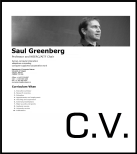|
Saul Greenberg |
Brief Biography
Saul Greenberg is a Faculty Professor and Emeritus Professor in the Department of Computer Science at the University of Calgary. He holds the NSERC/AITF/Smart Technologies Industrial Chair in Interactive Technologies. He was inducted as an ACM Fellow in 2012, and was also elected to the prestigious ACM CHI Academy in April 2005 for his overall contributions to the field of Human Computer Interaction. He received the Canadian Human Computer Communications Society Achievement Award in May 2007. He also received a Lifetime Achievement Research Excellence Award from the Uinversity of Calgary, and has held a University Professorship which is itself a distinguished University of Calgary award recognizing research excellence. His work also received the ACM UIST Lasting Impact Award, and the ACM ISS 10-Year Impact Award. Saul has also consulted for various well-known companies as an Expert Witness involving patent infringement matters.
While he is a computer scientist by training, the work by Saul and his talented students typify the cross-discipline aspects of Human Computer Interaction, Computer Supported Cooperative Work, and Ubiquitous Computing. His many research contributions are bound by the common thread of situated interaction, which considers how computer technology fits within the fabric of people’s day to day activities. This includes how such technology blends naturally in the flow of people’s work practices, how people socialize and work together through technology, and how that technology fits within people’s physical environment.
He and his crew are well known for various significant contributions to the field, all necessary to pursue the broad goal of situated interaction.
- Articulation of design-oriented social science theories that serve as a requirements specification. For example, his team's work on the nuances of awareness in distributed groupware has been used extensively by others as the theoretical foundation behind their work.
- Innovative and seminal system designs based on observations of social phenomenon. For example, his team's work on digital surfaces (large, interactive digital wall and tables) led to the notion of mixed-presence groupware that let multiple co-located groups work with each other across distance. Another example is the commercialized Teamrooms system, and the later Notification Collage and Community Bar systems; these developed notions of room metaphors and of sidebars as a means to allow a group to stay aware of each other and easily move into real-time interaction.
- Toolkits enabling rapid prototyping of innovative groupware and ubiquitous appliances. For example, his team's work on the Proximity Toolkit promoted rapid protoyping of device ecologies, where devices leverage knowledge about their relative distance and orientation to each other. Phidgets are a hardware/software toolkit that lets designers rapidly build computer-controlled physical interfaces. They have been commercialized, and have become the de-facto standard for teaching and for prototyping such systems. Earlier, the Groupkit groupware toolkit was the first such system that allowed developers to rapidly create and experiment with distributed groupware.
- Refinement of evaluation methods, where a plethora of methods have been developed to help researchers and developers rapidly evaluate the systems they were building. Examples include discount usability methods specific to groupware, and debates about the limits of usability evaluation as a testing method.
Dr. Greenberg has also consulted for various well-known companies as an Expert Witness involving patent infringement matters.
He is also the creator of the Timelapse image analyser, used internationally by various researchers and agencies to encode data from thousands to millions of camera trap images.
Dr. Greenberg is a prolific author with a high impact factor. His work is highly cited: Google Scholar states his H-Index is 101with ~35,000 citations. He has authored and edited several books and published many refereed articles, as listed at his research web site. He is also known for his strong commitment in making his tools, systems, and educational material readily available to other researchers and educators.
A shorter bio is also available.


